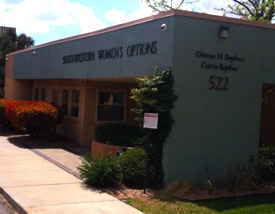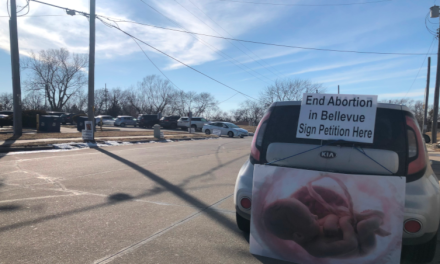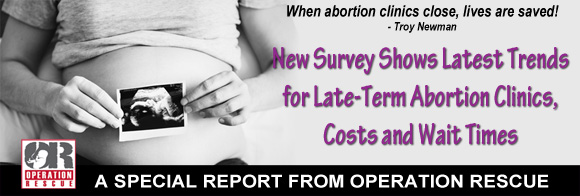
An Operation Rescue Special Report (Part Two of Two)
[Note: This report has been updated with revised numbers for 2018.]
By Cheryl Sullenger
As an imploding abortion industry struggles to remain solvent amid a falling demand for abortions, there have been significant shifts in how abortions are being done and how late into pregnancy abortion clinics are willing to do them, according to new information gathered during Operation Rescue’s 2018 Abortion Clinic Survey.
Each year, Operation Rescue conducts a nationwide survey that involves contacting each abortion business in the U.S. Information gathered about the abortion clinics and their practices represents the most accurate data available. The most recent survey was conducted from November 26 through December 14, 2018.
The survey also collected information about the cost of the most common abortions in the first trimester and how long women must wait for an abortion appointment, both of which have revealed insights into how the business of abortion is changing.
“These trends signal a certain level of desperation among abortionists to compete for every abortion dollar possible,” said Operation Rescue President Troy Newman. “Competition is fierce, and we are seeing organizations like Planned Parenthood and other abortion businesses reorganizing to stay afloat – not all of them successfully.”
In fact, Operation Rescue’s survey results indicated that U.S. abortion facility numbers dropped in 2018 to a historic low of 701. This decrease is in keeping with a national trend that has seen abortion facility numbers drop by 78 percent since 1991. (See Part One of this report.)
Perhaps the most significant trend shifts were related to surgical abortions.
- Surgical abortion facilities are slowly being replaced by clinics that offer abortion-inducing drugs that can only be used in the first-trimester of pregnancy.
- There has been a dramatic reduction in the number of facilities that conduct abortions at 20 weeks gestation or more.
Gestation Age Limits
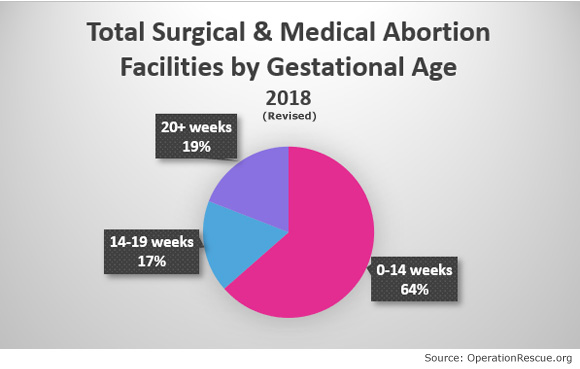
Operation Rescue analyzed the self-imposed gestational limits of each of the 701 abortion facilities in America.
Over all, clinics that restrict abortions to the first-trimester overwhelmingly outnumber those that are willing to abort in the later stages of pregnancy. This includes both surgical and medication-only abortion clinics.
A total of 443 surgical and medical abortion clinics confine themselves to first-trimester abortions (from conception). This represents 64 percent of all abortion clinics in the U.S.
Out of the 471 surgical abortion clinics, 213 limit abortions to 14 weeks (post conception) and under.
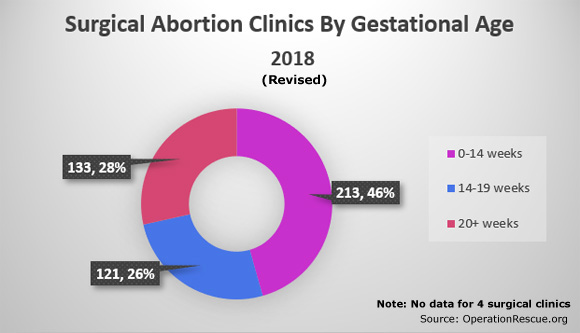
Of the 230 medical abortion facilities all confine the dispensing of abortion drugs to the current FDA-approved limit of 10 weeks gestation or under. None go beyond 10 weeks.
There are 121 clinics willing to venture into the riskier world of early second-trimester surgical abortions, yet will not go beyond the end of 19 weeks.
“We go as high as needed.”
Abortions done at 20 weeks or later gestation are riskier, rarer, and much more expensive. Nevertheless, there are 133 abortion clinics that conduct abortions this late into pregnancy.
In 2016, there were 164 abortion facilities that conducted abortions at 20 weeks or later — 31 more than 2018. This represents an impressive 19 percent reduction in the number of very-late-term abortion facilities over just the past two years.
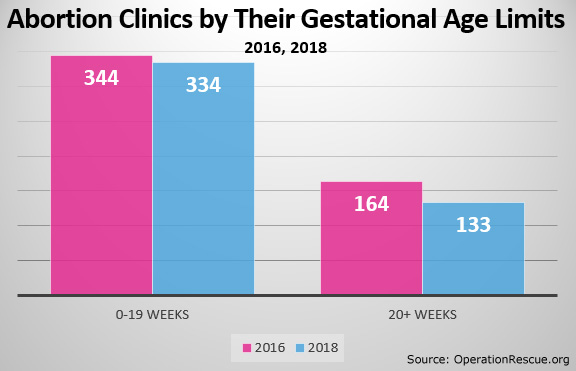
Planned Parenthood now occupies an ever-growing piece of a shrinking late-term abortion pie. Out of those 133 clinics that now conduct abortions at 20 weeks and later, 37 are Planned Parenthood facilities – more than double the 18 Planned Parenthood clinics that were willing to do such late abortions just two years ago.
This could be an indication that Planned Parenthood is attempting to expand into the expensive late-term abortion business where an abortion can cost several thousand dollars. There would certainly be a profit motive for such an expansion, especially in a time when more states are blocking Planned Parenthood’s public funding and a federal rule change will prevent them from receiving millions of tax dollars in Title X family planning grants this spring.
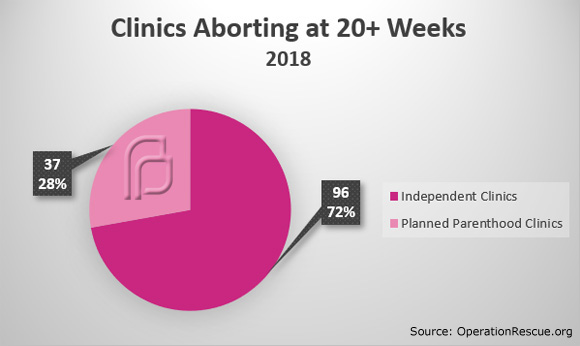
Ironically, despite evidence to the contrary, none of the late-term clinics admitted to doing abortions past 28 weeks, except for the Boulder Abortion Clinic, owned and operated by Warren Hern in Boulder, Colorado. His facility told an Operation Rescue investigator, “We go as high as needed.”
The number of abortion facilities that are publicly known to conduct abortions throughout all nine months of pregnancy have changed very little since 2009. None of them are Planned Parenthood affiliates. They include:
- Warren Hern’s Boulder Abortion Clinic in Boulder, Colorado. (Stated Limit: As high as needed)
- Curtis Boyd’s Southwestern Women’s Options in Albuquerque, New Mexico. (Stated limit: 28 weeks)
- LeRoy Carhart’s AbortionClinics.org in Bethesda, Maryland. (Stated limit: 27 weeks)
- Josepha Seletz’s Sinai Medical Center in Beverly Hills, California. (Stated limit: 24 weeks)
- Martin Haskell’s Women’s Med Center in Dayton, Ohio. (Stated limit: 22 weeks)
Abortion Costs
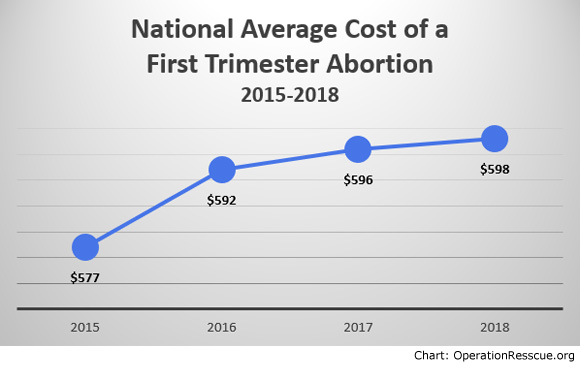
For at least the fourth consecutive year, the national average cost of a first-trimester abortion has increased. In 2018, the average cost was $598. That is 3.5 percent higher than in 2015.
Costs vary by the type of abortion and the kind of facility conducting the abortion.
The national average for first-trimester surgical abortions was $612.47 in 2018. Abortion-inducing drugs obtained at surgical abortion facilities cost an average of $583.79.
The same abortion drugs were actually higher at facilities that only offer abortion drugs. The average cost at those clinics was $596.72.
In fact, the average cost of an abortion at a medication abortion facility has risen higher and faster than abortion-inducing drugs obtained at facilities that also offer surgical abortions. This is despite lower overhead costs and the fact that they tend to be less regulated in many states. In California, for example, abortion drugs can be prescribed by non-physicians, including physician assistants, nurse practitioners, and midwives, who commonly earn less than licensed physicians.
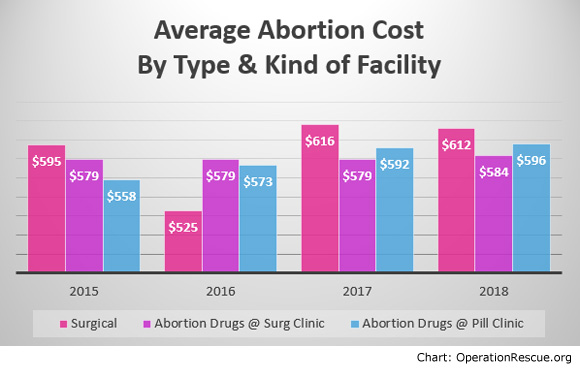
The state with the highest average cost for a first-trimester abortion is Wyoming at $1,099. The lowest cost was found in Virginia with the average price of $389 for a first-trimester surgical procedure.


Abortion Wait Times
In spite of claims from the Abortion Cartel that women must endure long waits to obtain abortions and dire predictions that pro-life legislation would result in increased wait times, survey results show that the opposite is actually true.
Today, from the time a woman contacts an abortion facility until the time she actually receives an abortion is an average of 6.56 days nationwide. That is down from an average wait of 8.5 days in 2015, even though the number of abortion facilities has decreased and a plethora of new state laws has been enacted since then.
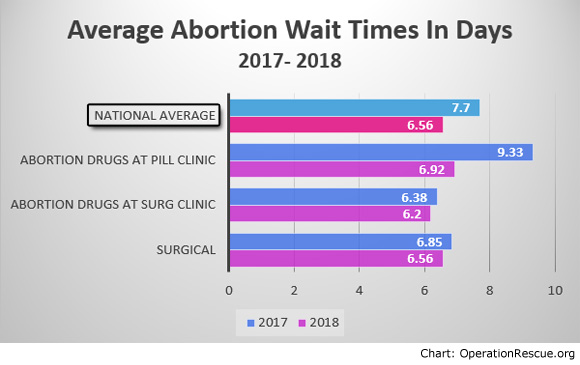
“Our data debunks the claims of the Abortion Cartel, who love fear-mongering over pro-life legislation without any factual basis for their angst,” said Operation Rescue President Troy Newman. “While we would prefer to see average abortion wait times increase, our data clearly shows the hysteria over how long women wait to receive abortion is completely fallacious and is wrongly being used to oppose life-saving legislation around the country.”
Conclusions
Overall, Operation Rescue’s 2018 survey of abortion clinics shows that while the number of abortion facilities are decreasing, the number of late-term abortion facilities is falling at a much greater rate.
This could be the result of a dropping demand for the unpopular and expensive late-term abortion procedures. Pro-life efforts to expose these gruesome abortions and their high risk factors, along with a public political dialogue about abortion appear to have influenced this trend.
Planned Parenthood’s rapid growth into the very late-term abortion market is notable. This expansion took place under the leadership of former CEO Cecile Richards. With Planned Parenthood now under the leadership of Leana Wen, who is attempting to focus the public on other services Planned Parenthood provides, it will be interesting to see if their expansion into the very late-term abortion market continues.
The price of an abortion continues to rise. Abortion clinics are struggling to meet new state laws, keep abortionists on staff, and cope with an overall decrease in demand for abortions. It is likely that abortion businesses are attempting to offset their losses by passing price increases on to their customers.
With brisk competition for every abortion dollar, clinics appear particularly motivated to get women in for abortions as soon as they possibly can to reduce the chances women might change their minds or go elsewhere. This is reflected in the lower average wait time for abortion.
The evidence of shorter waits on average for abortion appointments soundly discredits pro-abortion arguments that pro-life laws have caused women to endure long wait times.
“I am very pleased with the results of the 2018 survey. It shows overall that abortion clinics are closing faster than they are opening and that efforts to counter that trend by the Abortion Cartel have not been successful,” said Newman. “When abortion clinics close, lives are saved. We can take heart in knowing that the days of child-killing through abortion in this country are numbered.”
___________________
Read Part One: Abortion Facility Numbers Continue to Decrease in 2018 According to New Survey


